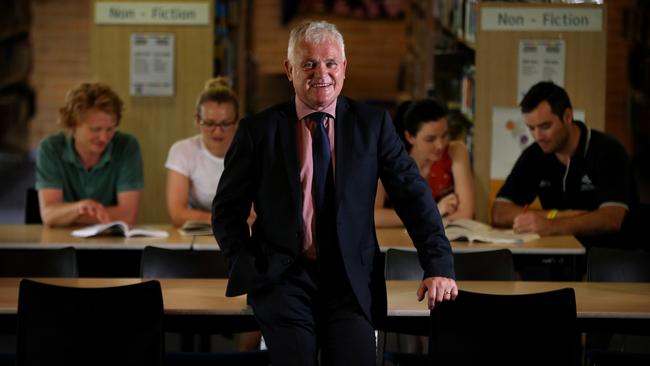Teaching how to be all class
The best schoolsare those where a person can walk in and feel a positive vibe, a principals association says.

The best schools in Australia are those where a person can walk in and feel a positive vibe, which comes down to collaborative leadership, says the Australian Secondary Principals Association.
“You can tell by the students, by the teachers, by the atmosphere in the school,” executive director Rob Nairn says.
“It’s the conversations you have with the staff, with the parents, with the students as you go in; you know when they’re performing well that it’s a good school.”
The high school system is evolving into an educational ecosystem, Nairn says, as principals react to changing technology, regular testing and data analytics, and the need to teach adaptive skills to prepare students for a global workforce.
Principals, long held as the school leader responsible for education, are adapting to become business leaders overseeing curriculums while handling big budgets, demands for more money and increased pressure from parents for better results.
“We define schools as ecosystems, they’re constantly changing, and we need people who can change with them, adapt, build relationships with parents and work in an innovative environment to improve learning,” Nairn says.
While independent schools increasingly are employing directors to oversee the business-related aspects of a school such as fundraising, budgets and fees, Nairn says principals still need to be teachers and understand education to ensure their students excel, while pressured to improve results.
In an ideal world schools would work better with directors and principals, he says, but most cannot afford both. To ensure both roles can be filled by one person, Nairn says, high schools should be focusing on finding the right leaders for their environment rather than just employing the self-nominating best candidate.
Those who put their hand up can sometimes fail to meet great leadership criteria and Nairn says a top school principal should identify future leaders and offer opportunities instead.
That could mean offering internships to potential leaders or appointing them as year-level co-ordinators. That also could mean ignoring some candidates and hand-picking others.
“We wonder whether we’re putting people into the role who are ready for that role,” Nairn says. “Most of our inexperienced people will go into our most isolated schools and we wonder why they struggle.
“Instead, we should say: ‘We think you need to go to a particular school and we will train you to go there, and we’ll send another person there to train you, and you can take over in two years’ time.’ ”
Good school principals are also those who talk about collective leadership, Nairn says, which means taking teachers, parents and students on a journey where they can be involved and take ownership of education.
One of those leaders is Erindale College principal Michael Hall. Across the past decade, Hall has transformed the senior government secondary school in Canberra into a centre of excellence, with specialist academies in English and languages; enterprise; sports; innovation and arts; international studies; and mathematics, IT and science. Erindale is the only government school of 10 nationally accredited Cambridge International schools.
The Cambridge model allows students to pick a specialisation and sit international exams that are the equivalent of Britain’s A-levels, compete internationally and facilitate entry into world-leading universities including Cambridge, Oxford and US Ivy League institutions.
“Students coming in here with incredible academic abilities should be able to present those on a world stage,” Hall says.
Hall began transforming Erindale into an academic powerhouse a decade ago, when a group of teachers asked to attend a maths conference in Tasmania.
He weighed up whether the $10,000 cost would be better spent on maths equipment, and told his staff that if they were to go, they needed to come back with ideas to make positive changes worth that value. The teachers reorganised desks from rows to groups, which fundamentally changed the way students learned concepts and worked together. Then they travelled to the Australian Science and Mathematics School in Adelaide to look at its innovative learning methods.
“From there they changed not only their curriculum, they changed their pedagogy,” Hall says.
Hall’s maths department spent $100,000 to redesign class spaces, create maths with meaning and allow students to learn differently.
“If we can change a maths faculty, we get other staff saying they want to do what they’re doing,” Hall says. “They’re advocating change in other spaces.”
Melba Copland Secondary School principal Michael Battenally, a 33-year teaching veteran, says good leadership comes down to creating order and a learning environment with support from teachers and deputies, being a good coach, and understanding your community.
Another is communicating with parents, teachers and support staff effectively, which he says can be difficult in the days of emails and instant messaging.
“We’re on a bit of a rollercoaster and we’re grappling with technology and how best to use it,” Battenally says.
“Sometimes I’m overwhelmed by the number of emails I get in a day and having to deal with them, we have to deal with a tsunami of communication coming our way.”
He encourages staff to pick up the phone and talk instead of sending seven messages.
Social interaction also can be good for mental health, and he says principals these days are battling with greater stress than ever.
“Principals are becoming more aware of their own wellbeing and it’s something they build into their own role and how they behave,” Battenally says. “My advice is make sure you engage in exercise and have a healthy lifestyle, though you can still have a couple of beers at home.”


